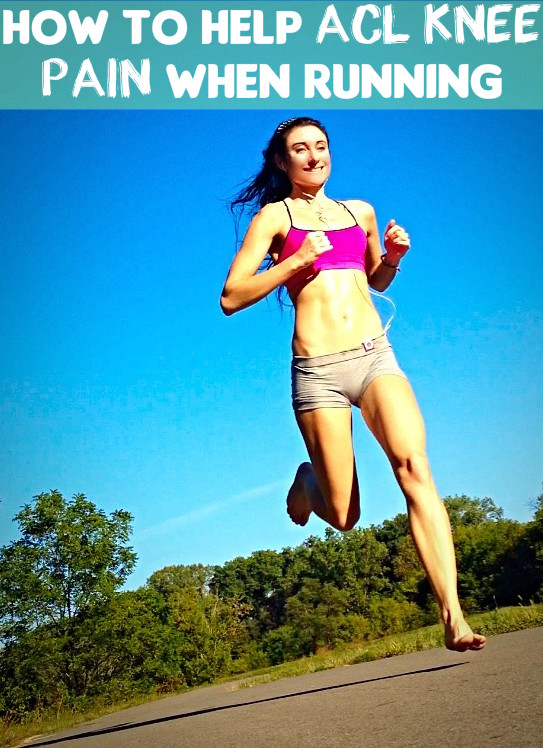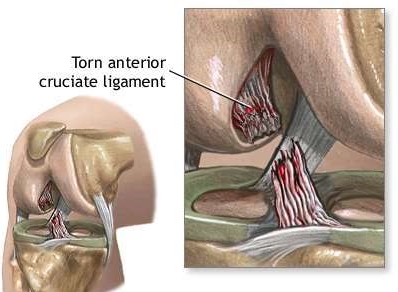Many runners with ACL knee pain symptoms heel strike and strike the ground with less knee flexion — less knee flexion at touchdown in running is a risk factor for knee osteoarthritis. However, forefoot running in barefoot running shoes, or running barefoot which is even better, improves knee function by encouraging the right level of knee flexion.
How Runners Can Reduce ACL Knee Pain Symptoms
Piles of research has shown that reduced knee flexion during running, particularly heel strike running, increases cartilage degeneration of the knee-joint over-time.
- Reduced knee flexion impairs dynamic force absorption, leading to inadequate loading patterns on the body during jogging.
In the past, poor quadricep strength was thought to cause reduced knee flexion in joggers. Now, heel striking when running in cushioned running shoes has been identified in robbing us of the right amount of knee flexion needed to absorb impact and protect the body as well as the knee-joint itself.
Because soft, cushioned running shoes, like most regular running shoes, trigger low knee flexion, a jogger with painful ACL knees should wear barefoot-inspired running shoes to prevent subsequent knee injury. Here’s why:
An ultra thin outsole allows for greater proprioception of the foot which ultimately controls knee flexion, therefore joggers with a pulled ACL would benefit from wearing less on their feet.
- Plantar proprioception determines the degree of knee flexion in response to plantar stimuli during running.
- More proprioceptors that are activated on the soles of the feet systematically improves reflexivity in the knee joint structure.
Because knee flexion is reflexive, the plantar proprioceptors need to be fully activated to ensure optimal flexion within the knee during running.
Proprioceptors determine the degree of knee flexion in response to plantar stimuli.
- Footwear, or lack thereof, is a critical interface between proprioception and joint kinematics.
- Proprioception, part of the neuromotor system, helps control movement, perceptual awareness and reflexes. Proprioception also plays a crucial role in how the knees act as a natural shock absorber during jogging.
Because proprioception increases with less material under the feet, minimalist footwear keeps us engaged in reflexive behaviors, such as increased knee flexion, important to absorb forces at the knee. Joggers with cruciate ligament symptomts would therefore benefit from minimalist footwear because these shoes prevent a loss of function in the knee by strengthening neural networks underlying motor structures that control knee flexion.
Therefore, barefoot running shoes inconjuction with forefoot running play a crucial role when it comes to the knee’s ability to absorb impact as well as protecting the knee as compared with regular running shoes.
More From Run Forefoot:
- A potential source of injury for Mo Farah
- KT tape does little to improve biomechanics
- What is the proper arm swing for running
- Top barefoot running shoe brands for forefoot runners
- How forefoot running absorbs more impact than heel strike running
References:
Andriacchi TP, Koo S, Scanlan SF. Gait mechanics influence healthy cartilage morphology and osteoarthritis of the knee. J Bone Joint Surg Am. 2009;91(1 suppl):95–101.
Andriacchi TP, Mundermann A. The role of ambulatory mechanics in the initiation and progression of knee osteoarthritis. Curr Opin Rheumatol. 2006;18(5):514–8.
Butler RJ, Minick KI, Ferber R, Underwood F. Gait mechanics after ACL reconstruction: implications for the early onset of knee osteoarthritis. Br J Sports Med. 2009;43(5):366–70.
Hart JM, Ko JW, Konold T, Pietrosimone B. Sagittal plane knee joint moments following anterior cruciate ligament injury and reconstruction: a systematic review. Clin Biomech (Bristol, Avon). 2010;25(4):277–83.
Hooper DM, Morrissey MC, Drechsler WI, Clark NC, Coutts FJ, McAuliffe TB. Gait analysis 6 and 12 months after anterior cruciate ligament reconstruction surgery. Clin Orthop Relat Res. 2002;(403): 168–78.
Kuenze et al. Jogging biomechanics after exercise in individuals with ACL-Reconstructed Knees. Med Sci Sports Exerc, 2014; 1067-1076.
Lewek M, Rudolph K, Axe M, Snyder-Mackler L. The effect of insufficient quadriceps strength on gait after anterior cruciate ligament reconstruction. Clin Biomech (Bristol, Avon). 2002;17(1): 56–63.
Timoney JM, Inman WS, Quesada PM, et al. Return of normal gait patterns after anterior cruciate ligament reconstruction. Am J Sports Med. 1993;21(6):887–9.
Webster KE, McClelland JA, Palazzolo SE, Santamaria LJ, Feller JA. Gender differences in the knee adduction moment after anterior cruciate ligament reconstruction surgery. Br J
Sports Med. 2012;46(5):355–9.
Webster KE, Wittwer JE, O’Brien J, Feller JA. Gait patterns after anterior cruciate ligament reconstruction are related to graft type. Am J Sports Med. 2005;33(2):247–54.
Bretta Riches
BSc Neurobiology; MSc Biomechanics candidate, ultra minimalist runner & founder of RunForefoot. I was a heel striker, always injured. I was inspired by the great Tirunesh Dibaba to try forefoot running. Now, I'm injury free. This is why I launched Run Forefoot, to advocate the health & performance benefits of forefoot running and to raise awareness on the dangers of heel striking, because the world needs to know.
Latest posts by Bretta Riches (see all)
- Does Foot Strike Really Matter in Running? YES! - 17/04/2024
- Heel Lifts Increase Injury in Runners - 16/04/2024
- Are Minimalist Shoes Good for Seniors? YES! - 14/04/2024



Leave a Reply